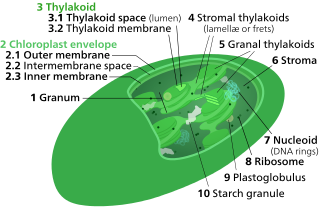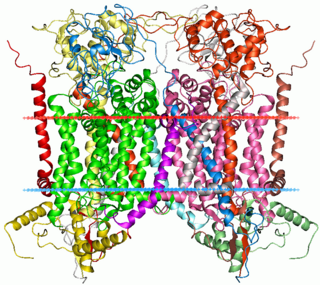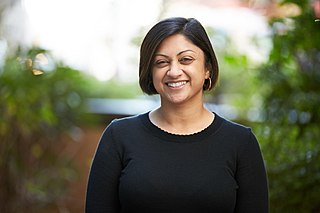Related Research Articles

Chlamydomonas is a genus of green algae consisting of about 150 species of unicellular flagellates, found in stagnant water and on damp soil, in freshwater, seawater, and even in snow as "snow algae". Chlamydomonas is used as a model organism for molecular biology, especially studies of flagellar motility and chloroplast dynamics, biogenesis, and genetics. One of the many striking features of Chlamydomonas is that it contains ion channels (channelrhodopsins) that are directly activated by light. Some regulatory systems of Chlamydomonas are more complex than their homologs in Gymnosperms, with evolutionarily related regulatory proteins being larger and containing additional domains.

Thylakoids are membrane-bound compartments inside chloroplasts and cyanobacteria. They are the site of the light-dependent reactions of photosynthesis. Thylakoids consist of a thylakoid membrane surrounding a thylakoid lumen. Chloroplast thylakoids frequently form stacks of disks referred to as grana. Grana are connected by intergranal or stromal thylakoids, which join granum stacks together as a single functional compartment.

Pyrenoids are sub-cellular micro-compartments found in chloroplasts of many algae, and in a single group of land plants, the hornworts. Pyrenoids are associated with the operation of a carbon-concentrating mechanism (CCM). Their main function is to act as centres of carbon dioxide (CO2) fixation, by generating and maintaining a CO2 rich environment around the photosynthetic enzyme ribulose-1,5-bisphosphate carboxylase/oxygenase (RuBisCO). Pyrenoids therefore seem to have a role analogous to that of carboxysomes in cyanobacteria.

Chlamydomonas reinhardtii is a single-cell green alga about 10 micrometres in diameter that swims with two flagella. It has a cell wall made of hydroxyproline-rich glycoproteins, a large cup-shaped chloroplast, a large pyrenoid, and an eyespot that senses light.

Photosystem I is one of two photosystems in the photosynthetic light reactions of algae, plants, and cyanobacteria. Photosystem I is an integral membrane protein complex that uses light energy to catalyze the transfer of electrons across the thylakoid membrane from plastocyanin to ferredoxin. Ultimately, the electrons that are transferred by Photosystem I are used to produce the moderate-energy hydrogen carrier NADPH. The photon energy absorbed by Photosystem I also produces a proton-motive force that is used to generate ATP. PSI is composed of more than 110 cofactors, significantly more than Photosystem II.

The cytochrome b6f complex (plastoquinol/plastocyanin reductase or plastoquinol/plastocyanin oxidoreductase; EC 7.1.1.6) is an enzyme found in the thylakoid membrane in chloroplasts of plants, cyanobacteria, and green algae, that catalyzes the transfer of electrons from plastoquinol to plastocyanin:

Cytochrome b within both molecular and cell biology, is a protein found in the membranes of aerobic cells. In eukaryotic mitochondria and in aerobic prokaryotes, cytochrome b is a component of respiratory chain complex III — also known as the bc1 complex or ubiquinol-cytochrome c reductase. In plant chloroplasts and cyanobacteria, there is an homologous protein, cytochrome b6, a component of the plastoquinone-plastocyanin reductase, also known as the b6f complex. These complexes are involved in electron transport, the pumping of protons to create a proton-motive force (PMF). This proton gradient is used for the generation of ATP. These complexes play a vital role in cells.

Biohydrogen is H2 that is produced biologically. Interest is high in this technology because H2 is a clean fuel and can be readily produced from certain kinds of biomass, including biological waste. Furthermore some photosynthetic microorganisms are capable to produce H2 directly from water splitting using light as energy source.

Light-dependent reactions are certain photochemical reactions involved in photosynthesis, the main process by which plants acquire energy. There are two light dependent reactions: the first occurs at photosystem II (PSII) and the second occurs at photosystem I (PSI).
The Gilbert Morgan Smith Medal is awarded by the U.S. National Academy of Sciences "in recognition of excellence in published research on marine or freshwater algae." It has been awarded every three years since 1979.

In molecular biology, the Ycf4 protein is involved in the assembly of the photosystem I complex which is part of an energy-harvesting process named photosynthesis. Without Ycf4, photosynthesis would be inefficient affecting plant growth. Ycf4 is located in the thylakoid membrane of the chloroplast. Ycf4 is important for the light dependent reaction of photosynthesis. To date, three thylakoid proteins involved in the stable accumulation of PSI have been identified, these are as follows:

Arthur Robert Grossman is an American biologist whose research ranges across the fields of plant biology, microbiology, marine biology, phytochemistry, and photosynthesis. He has been a staff scientist at Carnegie Institution for Science’s Department of Plant Biology since 1982, and holds a courtesy appointment as professor in the Department of Biology at Stanford. He has mentored more than fifteen PhD students and more than thirty post-doctoral fellows. Grossman was the recipient of the Gilbert Morgan Smith Medal in 2009 and the Darbaker Prize for work on microalgae in 2002. He is co-editor in chief of Journal of Phycology, and has been on the editorial boards of major biological journals including the Annual Review of Genetics, Eukaryotic Cell, Journal of Biological Chemistry, and Molecular Plant among others. He has also been on many committees and panels that evaluate scientific directions for the various granting agencies, universities and government departments. He was elected the co-chair of the Gordon Research Conference on Photosynthesis in 2015, and will be chair again in 2017. He is Chief of Genetics at Solazyme Inc. which applies plant biology to create oils.

Susanne von Caemmerer FRS is a professor and plant physiologist in the Division of Plant Sciences, Research School of Biology at the Australian National University; and the Deputy Director of the ARC Centre of Excellence for Translational Photosynthesis. She has been a leader in developing and refining biochemical models of photosynthesis.

Prachee Avasthi is a Professor of Anatomy and Cell Biology and Science Communicator at Dartmouth College and a co-founder, chief scientific advisor, and incoming CSO at Arcadia Science in Berkeley, California. She works on upwardly motile Chlamydomonas reinhardtii and is on the Board of Directors of eLife.
Francis-André Wollman is a French biologist born on 5 May 1953. He is a research director at the CNRS and works at the Institut de biologie physico-chimique (IBPC) in Paris. He is a member of the French Academy of sciences.

Maureen Hanson is an American molecular biologist and Liberty Hyde Bailey Professor in the Department of Molecular Biology and Genetics at Cornell University in Ithaca, New York. She is a joint member of the Section of Plant Biology and Director of the Center for Enervating Neuroimmune Disease. Her research concerns gene expression in chloroplasts and mitochondria, photosynthesis, and the molecular basis of the disease Myalgic Encephalomyelitis/Chronic Fatigue Syndrome (ME/CFS).
Alice Cheung is an American biochemist who is a professor of molecular biology at the University of Massachusetts Amherst. Her research considers the molecular and cellular biology of polarization. She was elected a Fellow of the American Association for the Advancement of Science in 2020.
Rachel Leech was Professor of Plant Sciences at the University of York, UK. Her research focused on chloroplasts and she was a leader in the field of understanding their development and function. She was also one of the early adopters of Arabidopsis thaliana as a model plant to identify the genes involved in chloroplast division.

Mary Belle Allen was an American botanist, chemist, mycologist, algologist, and plant pathologist, and a pioneer of biochemical microbiology. With Daniel I. Arnon and F. Robert Whatley, she did breakthrough research discovering and demonstrating the role of chloroplasts in photosynthesis. In 1962 she received the Darbaker Prize from the Botanical Society of America for her work on microbial algae. In 1967 she was nominated jointly with Arnon and Whatley for a Nobel Prize.
Christoph Benning is a German–American plant biologist. He is an MSU Foundation Professor and University Distinguished Professor at Michigan State University. Benning's research into lipid metabolism in plants, algae and photosynthetic bacteria, led him to be named Editor-in-Chief of The Plant Journal in October 2008.
References
- ↑ Merchant, Sabeeha (1998). Molecular Biology of Chlamydomonas: Chloroplasts and Mitochondria. Advances in Photosynthesis. Springer. ISBN 978-0-7923-5174-0
- ↑ Sabeeha Merchant publications from Europe PubMed Central
- 1 2 3 4 5 6 7 8 9 10 11 12 13 Davis, Tinsley H. (2015-03-03). "Profile of Sabeeha Merchant". Proceedings of the National Academy of Sciences. 112 (9): 2633–2634. Bibcode:2015PNAS..112.2633D. doi: 10.1073/pnas.1500798112 . ISSN 0027-8424. PMC 4352817 . PMID 25675533.
- ↑ "Indian-American scientist honoured by US". indiatimes.com. The Times of India. February 9, 2006. Retrieved 2019-05-23.
- 1 2 "MGM 2007". www.chem.uzh.ch. Retrieved 2019-05-23.
- ↑ "Meet our new faculty: Sabeeha Merchant, biology". Berkeley News. 2018-11-26. Retrieved 2019-05-23.
- ↑ "Merchant publications from Ph.D. thesis research". www.chem.ucla.edu. Retrieved 2019-05-23.
- ↑ Merchant, Sabeeha. "Lawrence Bogorad 1921 - 2003: A Biographical Memoir" (PDF). NAS. Retrieved 2019-05-23.
- ↑ "Studies on chloroplast development in Chlamydomonas reinhardtii IV. Control of rapid chlorophyll formation in greening y-1 cells". Plant and Cell Physiology. 1976. doi:10.1093/oxfordjournals.pcp.a075363. ISSN 1471-9053.
- ↑ Merchant, S; Bogorad, L (1986). "Regulation by copper of the expression of plastocyanin and cytochrome c552 in Chlamydomonas reinhardi". Molecular and Cellular Biology. 6 (2): 462–9. doi:10.1128/mcb.6.2.462. OCLC 679283371. PMC 367534 . PMID 3023849.
- ↑ Merchant, S.; Bogorad, L. (1987). "Metal ion regulated gene expression: use of a plastocyanin-less mutant of Chlamydomonas reinhardtii to study the Cu(II)-dependent expression of cytochrome c-552". The EMBO Journal. 6 (9): 2531–2535. doi:10.1002/j.1460-2075.1987.tb02540.x. ISSN 0261-4189. PMC 553670 . PMID 2824187.
- ↑ Kerfeld, Cheryl A.; Anwar, Haroon P.; Interrante, Robert; Merchant, Sabeeha; Yeates, Todd O. (1995). "The Structure of Chloroplast Cytochromec6at 1.9 Å Resolution: Evidence for Functional Oligomerization". Journal of Molecular Biology. 250 (5): 627–647. doi:10.1006/jmbi.1995.0404. ISSN 0022-2836. PMID 7623381.
- ↑ Redinbo, Matthew R.; Cascio, Duilio; Choukair, Marie K.; Rice, Danny; Merchant, Sabeeha; Yeates, Todd O. (1993-10-12). "The 1.5-.ANG. crystal structure of plastocyanin from the green alga Chlamydomonas reinhardtii". Biochemistry. 32 (40): 10560–10567. doi:10.1021/bi00091a005. ISSN 0006-2960. PMID 8399201.
- 1 2 "Gilbert Morgan Smith Medal". www.nasonline.org. Retrieved 2019-05-23.
- ↑ Grossman, Arthur R.; Rokhsar, Daniel S.; Grigoriev, Igor V.; Zhou, Kemin; Werner, Gregory; Szajkowski, Lukasz; Porter, Aaron; Poliakov, Alexander; Otillar, Bobby (2007-10-12). "The Chlamydomonas Genome Reveals the Evolution of Key Animal and Plant Functions". Science. 318 (5848): 245–250. Bibcode:2007Sci...318..245M. doi:10.1126/science.1143609. ISSN 0036-8075. PMC 2875087 . PMID 17932292.
- ↑ Merchant, S. S. (2009). "His protects heme as it crosses the membrane". Proceedings of the National Academy of Sciences. 106 (25): 10069–10070. Bibcode:2009PNAS..10610069M. doi: 10.1073/pnas.0905189106 . ISSN 0027-8424. PMC 2700887 . PMID 19541628.
- ↑ "Humboldt Research Award for Prof. Dr. Sabeeha Merchant". www.mpimp-golm.mpg.de. Retrieved 2019-05-23.
- ↑ "Sabeeha Merchant appointed director, UCLA-Department of Energy Institute". UCLA. Retrieved 2019-05-23.
- ↑ "Meet our new faculty: Sabeeha Merchant, biology". Berkeley News. 2018-11-26. Retrieved 2019-05-23.
- 1 2 "SMerchant | Department of Plant & Microbial Biology | UC Berkeley". plantandmicrobiology.berkeley.edu. Retrieved 2019-05-23.
- ↑ Delmer, Deborah (2 June 2004). "Preface by the Editor". Annual Review of Plant Biology. 55 (1). doi:10.1146/annurev.pp.55.042204.100001 . Retrieved 8 October 2021.
- ↑ Salomé, Patrice A. (18 October 2019). "Sabeeha Merchant". The Plant Cell. 31 (12): 2814–2816. doi:10.1105/tpc.19.00817. ISSN 1040-4651. PMC 6925020 . PMID 31628163 . Retrieved 8 October 2021.
- ↑ "Charles Albert Shull Award". ASPB. Retrieved 2019-05-23.
- ↑ "California prof gets National Science Award". Rediff. Retrieved 2019-05-23.
- ↑ "Newsroom". UCLA. Retrieved 2019-05-23.
- ↑ "Fellow of ASPB". ASPB. Retrieved 2019-05-23.
- ↑ "Charles F. Kettering Award". ASPB. Retrieved 2019-05-23.
- ↑ "Humboldt Research Award for Prof. Dr. Sabeeha Merchant". www.mpimp-golm.mpg.de. Retrieved 2019-05-23.
- ↑ "Sabeeha Merchant". www.nasonline.org. Retrieved 2019-05-23.
- ↑ "Sabeeha Merchant receives 2012 Darbaker Prize in Phycology | UCLA Chemistry and Biochemistry". www.chemistry.ucla.edu. Retrieved 2019-05-23.
- ↑ "Sabeeha Merchant elected to German National Academy of Sciences Leopoldina | UCLA Chemistry and Biochemistry". www.chemistry.ucla.edu. Retrieved 2019-05-23.
- ↑ https://aspb.org/membership/aspb-pioneer-members/